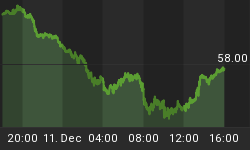In the absence of extreme bearish sentiment (i.e., bull signal) developing, it is unlikely that any upward price move in the major equity indices will last more than a couple of days and it is likely that selling will resume once those prices move towards the recent cyclical highs. Having more bears than bulls at the start of a rally provides short covering fuel and buyers on the sidelines willing to chase prices higher. These conditions don't exist even in the shortest of time frames. If you "buy the f—ing dip" make sure you "sell the f—ing rip".
The "Dumb Money" indicator (see figure 1) looks for extremes in the data from 4 different groups of investors who historically have been wrong on the market: 1) Investors Intelligence; 2) MarketVane; 3) American Association of Individual Investors; and 4) the put call ratio. This indicator is now neutral.
Figure 1. "Dumb Money"/ weekly
Figure 2 is a weekly chart of the SP500 with the InsiderScore "entire market" value in the lower panel. From the InsiderScore weekly report: "A 113% week-over-week increase in the number of insider buyers offset a 66% week-over-week increase in the number insider sellers and resulted in a neutral sentiment reading with some very positive elements. For starters, there was increasingly bullish sentiment within the Russell 2000, which has traditionally been the more predictive group of insiders as compared to the S&P 500, whose insiders displayed a rather typical sell bias last week (the latter group's constituents are more liberal with stock-based compensation). Market-wide, there was a strong number of Net Buy Inflections, something that was reflected by the high number of actionable buy transactions within the Technology and Industrial Goods sectors. There was also a positive turn in the Financial sector, where a rush of buying at Regional Banks and S&Ls (in particular in the Northeast and Mid-Atlantic regions) pushed sentiment to its best level of the calendar year. While there has been plenty of selling thus far this quarter, we're impressed and encouraged by the actionable buying we're seeing on a company-level and by the recent activity within the Russell 2000."
Figure 2. InsiderScore "Entire Market" value/ weekly
Figure 3 is a weekly chart of the SP500. The indicator in the lower panel measures all the assets in the Rydex bullish oriented equity funds divided by the sum of assets in the bullish oriented equity funds plus the assets in the bearish oriented equity funds. When the indicator is green, the value is low and there is fear in the market; this is where market bottoms are forged. When the indicator is red, there is complacency in the market. There are too many bulls and this is when market advances stall. Currently, the value of the indicator is 69.34%. Values less than 50% are associated with market bottoms. Values greater than 58% are associated with market tops. It should be noted that the market topped out in 2011 with this indicator between 70% and 71%.
Figure 3. Rydex Total Bull v. Total Bear/ weekly

TheTechnicalTake offers a FREE e-newsletter: HERE
















